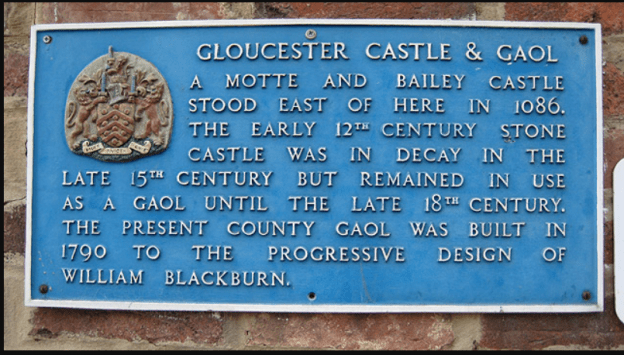Today’s find is another for my growing collection of posts on medieval common law, felony and mental disorders.[i] This time, we are in Gloucestershire, looking at a case in the King’s Bench plea roll for Michaelmas term, 1378,[ii] and the accused is a certain John le Botyler.
John was indicted as having committed two recent, violent and disturbing homicides. On the same day in 1378, he was said to have killed Elianor, daughter of Agnes Sheppester of Gloucester, at Hardwicke,[iii] and Nicholas Roger at Haresfield. The story was that both killings had been carried out using the same sword. He had hit Elianor in the back of the head with the sword, and, when she fell down under this blow, had stabbed her in the back. In the case of Nicholas, it had apparently been a face-to-face attack, as John stabbed Nicholas in the right hand part of his abdomen. It was noted, however, that John had done all of this whilst out of his right mind (extra memoriam existens).
Before the royal justices, John was asked how he pleaded, but he did not respond. The record noted that he appeared to be insane (tanquam furiosus & omnino extra memoriam apparet). An inquiry was ordered to be made into the matter of his mental state, using a jury made up both of those in Gloucester castle who had had charge of John following his arrest, and also of those from the locations of the two homicides. These jurors said that John was furiosus and extra memoriam. He was sent back to prison, in Gloucester castle, and the sheriff was responsible for his safe-keeping.
In the next Hilary term, the court was informed that John had become sane – devenit sane memorie – so the sheriff was ordered to bring him to court to answer the charges. After various delays, he came and seemed sane (apparet sane memorie). He pleaded not guilty and accepted jury trial. He was bailed to appear for the trial, with four men, including a ‘knight’ acting as security for his reappearance and good behaviour in the interim (on pain of losing £10). Eventually, there was a jury trial before assize justices, and the jury said he was not guilty of the felonies charged, so he was acquitted.
So what?
It’s hardly news that somebody rated mentally incapable would not suffer the punishment of a felon, nor, that, by this point, mercy would be delivered via a ‘not guilty’ verdict rather than going through the process of waiting for a pardon, as would have been the case in previous generations. Still, though, there are a couple of points of interest here.
As ever, we have the puzzle of just how disturbed a person would have to be before he would not be held liable for his crimes. In this case, the language is almost all about ‘memory’, and not being of sane/healthy ‘memory’. There is a bit of ‘fury’ talk as well, but the main impression relates to being in or out of ‘sane memory’. Retrospective diagnosis is both pointless and beyond me, but I do note this variation in the language used in these cases, the fact that there does seem to have been some ability to form a plan – in the first case, he did not just lash out wildly once, but hit the girl or woman when she was down from his first blow – and the interesting idea of his restoration to full ‘memory’ at some point after his killing spree and imprisonment. There is no suggestion that somebody is appointed to keep him under surveillance, or under lock and key, afterwards – he is simply free to go, assumed to be able to be reintegrated into Gloucestershire life. One wonders what would have been the view on this of the victims’ families.
I am also interested in the process of using John’s gaolers as well as other local men, as a sort of special jury, to give a view on his mental state. This process is reminiscent of both the ‘jury of matrons’ in claims of pregnancy, and also that used for people who stood mute when charged with a crime, to say whether they were unable to speak, or were ‘mute of malice’. It is an interesting hybrid of – in modern terms – witnesses and neighbours. It is probably not a surprise that there is no trace of an ‘expert’ assessment of John’s condition – this case is a good reminder that varied mental states were something assumed to be understood by, and clear to, ordinary men. For all that is difficult and disturbing about the treatment of those with mental disorders in the past, that idea that such problems were seen as an expected part of everyday experiences is a stimulating point of contact between people of the deep past and the present world in which we are (gradually) becoming a little more open to the idea of the normality of mental difference.
GS
7/4/2021
(image courtesy of Gloucester castle and gaol © Pauline E :: Geograph Britain and Ireland )
[i] (see also: Plague, fire and ‘lunacy’: arson and acquittal in medieval Yorkshire | Bracton’s Sister (bristol.ac.uk)
‘Lunacy’ and legal records | Bracton’s Sister (bristol.ac.uk)
‘Lunacy’ in a Legal Record | Bracton’s Sister (bristol.ac.uk)
[ii] KB 27/471 m. 13 d (AALT IMG 362).
[iii] ‘the Hollywood of Gloucester’, so Wikipedia says – will have to visit once we are free again and I can cadge a lift.
